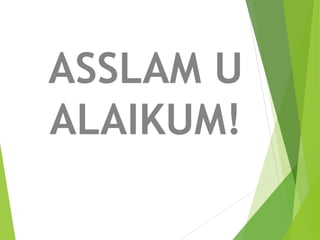
Behavioural approach to learning
- 3. Behaviourism It is a learning theory based on he idea, that Behaviour can be controlled & modified based on the consequences of a behaviour. Learning occurs by copying others. Learning occurs by Repetition.
- 4. There are two types of conditioning in Behaviourism. Classical Conditioning Operant Conditioning
- 6. What is conditioning? “A process of behavior modification by which a subject comes to associate a desired behavior with a previously unrelated stimulus is called conditioning.”
- 7. What is classical conditioning? Classical conditioning - a type of learning in which an organism learns to connect or associate, stimuli.
- 8. Pavlov’s Classical Conditioning Ivan Petrovich Pavlov (1849 – February 27, 1936) Famous Russian physiologist. Classical conditioning - a type of learning in which an organism learns to connect or associate, stimuli.
- 10. To fully understand Pavlov’s (1927) theory of classical conditioning we need to understand two types of stimuli and two types of responses: Unconditioned Stimulus (UCS) Unconditioned response (UCR) Conditioned Stimulus (CS) Conditioned Response (CR)
- 11. Conditioned Stimulus (CS) A previously neutral stimulus (NS) that eventually elicits a conditioned response after being associated with the UCS. Unconditioned Stimulus (UCS) A stimulus that automatically produces a response without any prior learning. (Food was the UCS in Pavlov’s esperiment) Unconditioned Response (UCR) An unlearned response that is automatically elicited by the UCS. (the dog’s salivation in response to food was the UCR) Conditioned Response(CR)
- 12. 1.Extinction : Weakening Conditioned Responses a conditioned response (salivation) will disappear over time when the conditioned stimulus (bell) is no longer presented. The response is the result of gradual weakening and vanishing of a conditioned response. As an example, after conditioning, the bell continues to ring at certain intermission without any meat powder given, and the rate of salivation would gradually reduce and finally stop after a period of time.
- 13. 2. Stimulus Generalization. refers to the conditioned response of an organism that applies not only to the real, original conditioned stimulus, but also to other stimuli that are alike. after conditioning, there are possibilities for Pavlov’s dog to respond to different kind of bell sound in different situation. stimulus generalization occurs when an individual is able to respond the same way to any other stimuli that are similar with the original stimuli.
- 14. Implications of Pavlov’s Conditioning Theory in Teaching Learning
- 15. Before Conditioning During Conditioning After Conditioning Science Teacher (UCS) teaching in the class for the first time. Unconditioned response (pupil’s attention) towards the teaching activities only. Teacher (CS) teaching in an interesting manner. Pupils pay attention to teacher’s teaching (CR). Teacher’s presence (CS). Pupils pay attention to teacher’s teaching (CR)
- 16. Before Conditioning “book” verbally expressed by pupils (UCS ------------------------------------------------------------ >UCR)
- 17. During Conditioning CR -- UCS --> Book (CS) “book” verbally expressed by the students
- 18. After Conditioning -------------> Book Pupils expressed “book” verbally
- 20. J. B. Watson (1878-1958) An American psychologist. The first person to use the term ‘behaviourism’ to study human behaviour. Research - influenced by Pavlov’s Classical Conditioning Theory. Famous research – related to children’s emotion
- 21. The experiment Together with colleague, Rosalie Rayner (1920), they used a nine-month old baby, named Little Albert and a white tame mouse to conduct the experiment.
- 22. 1. A white mouse was brought to Little Albert whom he showed interest to play with. 2. As soon as the white mouse was shown to Albert the second time, a loud, startling sound was emitted all of a sudden from the back. 3. Immediately, Albert’s reaction was panic and frightened. 4. After conditioned response was established, Little Albert began to show fear of the white mouse itself.
- 23. Implications of Watson’s Learning Theory in Teaching and Learning 1. All types of behaviour can be learned through conditioning process. Positive behaviour can be taught by using suitable stimulus. 2. Pupils ought to relate the relationship between all responses systematically in order to master the skill of solving problems.
- 24. 3. More exercises should be carried out after learning in order to strengthen what has been learned in the memory 4. Teacher should use suitable stimulus during the teaching process to motivate pupils in learning, and at the same time, avoid using stimulus which will produce negative effect.
- 26. What is operant conditioning? Operant conditioning is an association made between a behavior and a consequence for that behavior.
- 27. B.F. Skinner 1904-1990 American psychologist, author, inventor, advocate for social reform, and poet. Wanted to find principles that controlled behavior. Wrote controversial books which describe utopian society based on rules of behaviorism.
- 28. REINFOCEMENT Ii is a process which strengthen a desired behaviour with in any organism.
- 29. REINFOCER Any event or stimulus, that when following a response, increases the probability that the response will occur again. Any event that strengthens the behavior it follows.
- 30. Types of reinforcement A. Positive reinforcement The reinforcement of a response by the addition or experiencing of a pleasurable stimulus. B. Negative reinforcement The reinforcement of a response by the removal, escape from, or avoidance of an unpleasant stimulus.
- 31. EXAMPLES children completing homework to earn a reward from a parent or teacher employees finishing projects to receive praise or promotions a child who lost recess privileges because he talk out of turn in class
- 32. Educational Implications We can use operant conditioning in classroom to enhance: Productivity Interest Behaviour modification Skills Conceptual Understanding Motivation
- 33. Any Question???
- 34. Thanks
